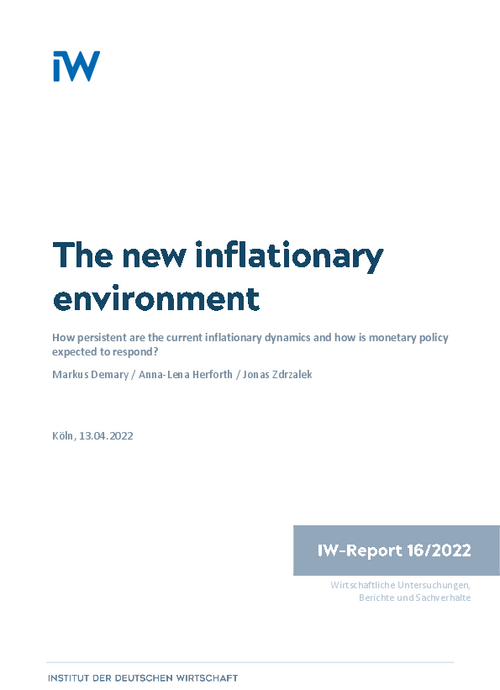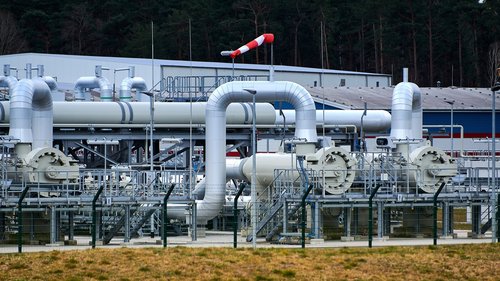We argue that the period of low inflation has come to an end based on six structural factors, which define the new inflationary environment.

The new inflationary environment: How persistent are the current inflationary dynamics and how is monetary policy expected to respond?

We argue that the period of low inflation has come to an end based on six structural factors, which define the new inflationary environment.
- De-Globalization gained momentum with the Zero-Covid policies in Asia which have caused disruptions in international shipments and thereby contributed to higher food prices as well as to higher prices for raw materials and intermediate products. It has further accelerated with the Russian invasion in Ukraine. As countries have started to lessen their energy-import dependency on Russia, the pandemic-related higher energy prices are expected to rise even further. Since a rise in oil prices is found to have an effect on the CPI for over 12 months, longer lasting effects are likely.
- Decarbonization is fostered through the introduction of CO2-prices and this price increase is necessary for the economy to transform away from fossil-fuels towards carbon-neutral energy. Because of adjustment costs for households in adapting to the higher energy prices by energy saving investments, the transition period is accompanied with rising energy expenditures for households.
- Demographics affect the labor markets globally in the longer term by enhancing the scarcity of workers and thereby increasing the competition to find skilled personnel. The tighter labor market offers the possibility to demand higher wages. This tightness can already be observed in the US. While short-term work schemes in the EU have prevented that a larger fraction of labor contracts have to be renegotiated, the situation is different in the US, where a large fraction of labor contracts has to be renegotiated, while the labor market has become tighter due to the reduction in the employment ratio.
- Digitalization has contributed to lower inflation. But due to temporary supply-side frictions, the scarcity of semi-conductors has led to increases in the prices of electronics. Given a higher demand for electronics during the digital transformation, the prices are expected to rise, thereby possibly ending the price decreasing effect of digital innovations on inflation.
- Fiscal policy in the US has led to an overheated economy with demand-driven inflation, while fiscal policy in Europe was more focused on shielding companies from the negative consequences of the pandemic by means of short-time work schemes and liquidity measures. However, the EU has to spend heavily on military equipment. Moreover, it has to invest in the transformation away from fossil-fuels in order to lessen its dependency on Russia. The fiscal response could probably lead to demand-driven inflation.
- Monetary policy has created a low interest rate and high liquidity environment, in which governments and companies have experienced favorable financing conditions. This environment was not inflationary for a longer time since governments and companies were in a process of debt consolidation. But this process has come to an end, since necessities to invest in carbon-neutrality and increases in military spending have emerged. While Eurozone inflation is predominantly energy-price driven, US inflation is mainly demand-driven. These different inflation causes yield different monetary policy responses which could lead to a positive interest rate differential between the US and the Eurozone. A weaker Euro would reinforce the energy-driven inflation in the Eurozone.
How high will inflation rise? How long will the new inflationary environment last? How challenging is it for central banks to counteract these inflationary pressures? A stagflation like in the 1970ies seems likely given these trends. The energy-crisis made the transformation of our energy systems necessary, which is, however, progressing slowly, thereby contributing to a longer lasting energy-triggered inflation. The most likely result is that central banks have to slow down economic activity or even start a recession to prevent a loss of confidence in their inflation targeting strategies and to prevent a de-anchoring of inflation expectations.

The new inflationary environment: How persistent are the current inflationary dynamics and how is monetary policy expected to respond?

More on the topic

The Energy Dependence of Bank Loans
Russia's war against Ukraine has highlighted the vulnerability of the Federal Republic of Germany to Russian energy imports, especially natural gas.
IW
This time is different but still risky: Banking crisis instead of financial crisis
The current crisis of some American and European banks inevitably triggers fears that an international banking crisis could lead to a new financial crisis. But things in 2023 are very different from those in 2007.
IW